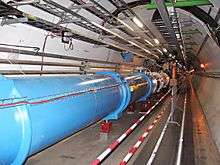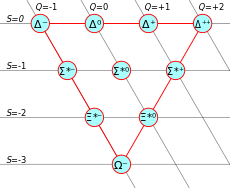Hyperon
| Standard Model of particle physics |
|---|
 Large Hadron Collider tunnel at CERN |
|
Scientists Rutherford · Thomson · Chadwick · Bose · Sudarshan · Koshiba · Davis Jr. · Anderson · Fermi · Dirac · Feynman · Rubbia · Gell-Mann · Kendall · Taylor · Friedman · Powell · P. W. Anderson · Glashow · Meer · Cowan · Nambu · Chamberlain · Cabibbo · Schwartz · Perl · Majorana · Weinberg · Lee · Ward · Salam · Kobayashi · Maskawa · Yang · Yukawa · 't Hooft · Veltman · Gross · Politzer · Wilczek · Cronin · Fitch · Vleck · Higgs · Englert · Brout · Hagen · Guralnik · Kibble · Ting · Richter |
In particle physics, a hyperon is any baryon containing one or more strange quarks, but no charm, bottom, or top quark.
Properties and behavior of hyperons

Being baryons, all hyperons are fermions. That is, they have half-integer spin and obey Fermi–Dirac statistics. They all interact via the strong nuclear force, making them types of hadron. They are composed of three light quarks, at least one of which is a strange quark, which makes them strange baryons. Hyperons decay weakly with non-conserved parity.
List of hyperons
| Particle | Symbol | Makeup | Rest mass MeV/c2 |
Isospin I |
Spin(Parity) JP |
Q | S | C | B' | Mean lifetime s |
Commonly decays to |
|---|---|---|---|---|---|---|---|---|---|---|---|
| Lambda [1] | Λ0 |
u d s |
1 115.683(6) | 0 | 1⁄2+ | 0 | −1 | 0 | 0 | 2.60×10−10 [2] | p+ + π− or n0 + π0 |
| Sigma [3] | Σ+ |
u u s |
1 189.37(0.7) | 1 | 1⁄2+ | +1 | −1 | 0 | 0 | (8.018±0.026)×10−11 | p+ + π0 or n0 + π+ |
| Sigma [4] | Σ0 |
u d s |
1 192.642(24) | 1 | 1⁄2+ | 0 | −1 | 0 | 0 | (7.4±0.7)×10−20 | Λ0 + γ |
| Sigma [5] | Σ− |
d d s |
1 197.449(30) | 1 | 1⁄2+ | −1 | −1 | 0 | 0 | (1.479±0.011)×10−10 | n0 + π− |
| Sigma resonance [6] | Σ∗+ (1385) |
u u s |
1 382.8(4) | 1 | 3⁄2+ | +1 | −1 | 0 | 0 | Λ + π or Σ + π | |
| Sigma resonance [6] | Σ∗0 (1385) |
u d s |
1 383.7±1.0 | 1 | 3⁄2+ | 0 | −1 | 0 | 0 | Λ + π or Σ + π | |
| Sigma resonance [6] | Σ∗− (1385) |
d d s |
1 387.2(5) | 1 | 3⁄2+ | −1 | −1 | 0 | 0 | Λ + π or Σ + π | |
| Xi [7] | Ξ0 |
u s s |
1 314.83(20) | 1⁄2 | 1⁄2+ | 0 | −2 | 0 | 0 | (2.90±0.09)×10−10 | Λ0 + π0 |
| Xi [8] | Ξ− |
d s s |
1 321.31(13) | 1⁄2 | 1⁄2+ | −1 | −2 | 0 | 0 | (1.639±0.015)×10−10 | Λ0 + π− |
| Xi resonance [9] | Ξ∗0 (1530) |
u s s |
1 531.80(32) | 1⁄2 | 3⁄2+ | 0 | −2 | 0 | 0 | Ξ + π | |
| Xi resonance [9] | Ξ∗− (1530) |
d s s |
1 535.0(6) | 1⁄2 | 3⁄2+ | −1 | −2 | 0 | 0 | Ξ + π | |
| Omega[10] | Ω− |
s s s |
1 672.45(29) | 0 | 3⁄2+ | −1 | −3 | 0 | 0 | (8.21±0.11)×10−11 | Λ0 + K− or Ξ0 + π− or |
Notes:
- Since strangeness is conserved by the strong interactions, the ground-state hyperons cannot decay strongly. However, they do participate in strong interactions.
Λ0
may also decay on rare occurrences via these processes:
Λ0
→
p+
+
e−
+
ν
e
Λ0
→
p+
+
μ−
+
ν
μ
-
Ξ0
and
Ξ−
are also known as "cascade" hyperons, since they go through a two-step cascading decay into a nucleon. - The
Ω−
has a baryon number of +1 and hypercharge of −2, giving it strangeness of −3.
It takes multiple flavor-changing weak decays for it to decay into a proton or neutron. Murray Gell-Mann's and Yuval Ne'eman's SU(3) model (sometimes called the Eightfold Way) predicted this hyperon's existence, mass and that it will only undergo weak decay processes. Experimental evidence for its existence was discovered in 1964 at Brookhaven National Laboratory. Further examples of its formation and observation using particle accelerators confirmed the SU(3) model.
Hyperon research
The first research into hyperons happened in the 1950s, and spurred physicists on to the creation of an organized classification of particles. Today, research in this area is carried out on data taken at many facilities around the world, including CERN, Fermilab, SLAC, JLAB, Brookhaven National Laboratory, KEK, and others. Physics topics include searches for CP violation, measurements of spin, studies of excited states (commonly referred to as spectroscopy), and hunts for exotic states such as pentaquarks and dibaryons.
See also
- Delta baryon
- Hypernucleus
- List of baryons
- List of particles
- Nucleon
- Physics portal
- Timeline of particle discoveries
References
- ↑ "Particle Data Groups: 2006 Review of Particle Physics – Lambda" (PDF). Retrieved 2008-04-20.
- ↑ "Physics Particle Overview – Baryons". Retrieved 2008-04-20.
- ↑ "Particle Data Groups: 2006 Review of Particle Physics – Sigma+" (PDF). Retrieved 2008-04-20.
- ↑ "Particle Data Groups: 2006 Review of Particle Physics – Sigma0" (PDF). Retrieved 2008-04-20.
- ↑ "Particle Data Groups: 2006 Review of Particle Physics – Sigma-" (PDF). Retrieved 2008-04-20.
- 1 2 3 "Particle Data Groups: 2006 Review of Particle Physics – Sigma(1385)" (PDF). Retrieved 2008-04-20.
- ↑ "Particle Data Groups: 2006 Review of Particle Physics – Xi0" (PDF). Retrieved 2008-04-20.
- ↑ "Particle Data Groups: 2006 Review of Particle Physics – Xi-" (PDF). Retrieved 2008-04-20.
- 1 2 "Particle Data Groups: 2006 Review of Particle Physics – Xi(1530)" (PDF). Retrieved 2008-04-20.
- ↑ "Particle Data Groups: 2006 Review of Particle Physics – Omega-" (PDF). Retrieved 2008-04-20.
- Henry Semat, John R. Albright (1984). Introduction to atomic and nuclear physics. Chapman and Hall. ISBN 0-412-15670-9.